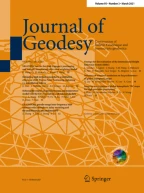Abstract
The Vienna Mapping Functions 1 (VMF1) as provided by the Institute of Geodesy and Geophysics (IGG) at the Vienna University of Technology are the most accurate mapping functions for the troposphere delays that are available globally and for the entire history of space geodetic observations. So far, the VMF1 coefficients have been released with a time delay of almost two days; however, many scientific applications require their availability in near real-time, e.g. the Ultra Rapid solutions of the International GNSS Service (IGS) or the analysis of the Intensive sessions of the International VLBI Service (IVS). Here we present coefficients of the VMF1 as well as the hydrostatic and wet zenith delays that have been determined from forecasting data of the European Centre for Medium-Range Weather Forecasts (ECMWF) and provided on global grids. The comparison with parameters derived from ECMWF analysis data shows that the agreement is at the 1 mm level in terms of station height, and that the differences are larger for the wet mapping functions than for the hydrostatic mapping functions and the hydrostatic zenith delays. These new products (VMF1-FC and hydrostatic zenith delays from forecast data) can be used in real-time analysis of geodetic data without significant loss of accuracy.
Similar content being viewed by others
References
Boehm J, Werl B, Schuh H (2006) Troposphere mapping functions for GPS and very long baseline interferometry from European Centre for Medium-Range Weather Forecasts operational analysis data. J Geophys Res 111:B02406. doi: 10.1029/2005JB003629
Boehm J, Schuh H (2007) Forecasting data of the troposphere used for IVS Intensive sessions. In: Boehm J, Pany A, Schuh H (eds) Proceedings of the 18th European VLBI for geodesy and astrometry working meeting, 12–13 April 2007, Geowissenschaftliche Mitteilungen, Heft Nr. 79, Schriftenreihe der Studienrichtung Vermessung und Geoinformation, Technische Universitaet Wien, pp 153–157. ISSN 1811–8380
Boehm J, Mendes Cerveira PJ, Schuh H, Tregoning P (2007) The impact of mapping functions for the neutral atmosphere based on numerical weather models in GPS data analysis. In: Tregoning P, Rizos C (eds) IAG symposium series, vol. 130. Springer, Heidelberg, pp 837–843
Dow JM, Neilan RE, Gendt G (2005) The international GPS service: celebrating the 10th anniversary and looking to the next decade. Adv Space Res 36(3): 320–326
Haas R, Wagner J, Mujunen A, Ritikari J, Müskens A, Dulfer C, Bertarini A (2007) e-VLBI transfer from Onsala and Metsähovi to the Bonn correlator. In: Boehm J, Pany A, Schuh H (eds) Proceedings of the 18th European VLBI for geodesy and astrometry Working meeting, 12–13 April 2007, Geowissenschaftliche Mitteilungen, Heft Nr. 79, Schriftenreihe der Studienrichtung Vermessung und Geoinformation, Technische Universitaet Wien, pp 27–32. ISSN 1811–8380
Héroux P, Kouba J (2001) GPS precise point positioning with IGS orbit products. Phys Chem Earth A 26: 573–578
Kouba J (2007) Implementation and testing of the gridded Vienna Mapping Function 1. J Geod. doi: 10.1007/s00190-007-0170-0
Niell AE (2000) Improved atmospheric mapping functions for VLBI and GPS. Earth Planets Space 52: 699–702
Niell AE (2006) Interaction of Atmosphere Modeling and VLBI Analysis Strategy, in International VLBI Service for Geodesy and Astrometry 2006 General Meeting Proceedings, edited by Dirk Behrend and Karen Baver, NASA/CP-2006-214140
Tesmer V, Boehm J, Heinkelmann R, Schuh H (2007) Effect of different tropospheric mapping functions on the TRF, CRF and position time-series estimated from VLBI. J Geod. doi: 10.1007/s00190-006-0126-9
Tregoning P, Herring TA (2006) Impact of a priori zenith hydrostatic delay errors on GPS estimates of station heights and zenith total delays. Geophys Res Lett 33. doi: 10.1029/2006GL027706
Author information
Authors and Affiliations
Corresponding author
Rights and permissions
About this article
Cite this article
Boehm, J., Kouba, J. & Schuh, H. Forecast Vienna Mapping Functions 1 for real-time analysis of space geodetic observations. J Geod 83, 397–401 (2009). https://doi.org/10.1007/s00190-008-0216-y
Received:
Accepted:
Published:
Issue Date:
DOI: https://doi.org/10.1007/s00190-008-0216-y
